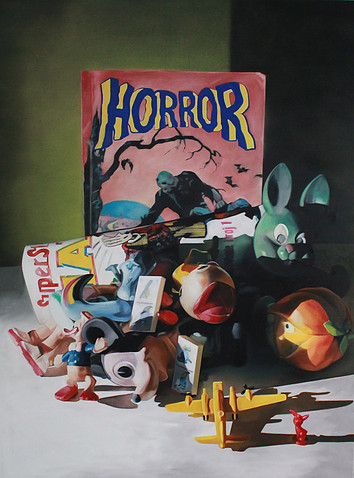History and memory – these are the primary themes in the artwork of Martina Grlić – a graduate of the Academy of Fine Arts, Zagreb, Croatia, who, in large, photorealistic paintings, documents and monumentalises the domestic, political and economic currents of the former Yugoslavia.
As of now, her portfolio is mainly divided into three parts – “Factory” Series, “Product Series” and “Atomic Landscapes”. We find women labouring away in food and garment factories, consumer items like chewing gums and brandy bottles and comic books and toys, a definite preoccupation with nuclear power. Even frolicsome moments from everyday life. Though everything is contained within a limited and specific temporal and geographical framework, there is a grand, epic quality to the scenes. On her creative process, Martina says, “I use a lot of photographs. Some I make myself – like in the Product series. But mostly I use whatever I can find in old books, albums, archives, Google or archive movies and documentaries. It takes a really great amount of my time and I enjoy it. I use photography or photo montage as a reference and try to upgrade it with my imagination.”

She started taking painting seriously in the third year of her academy education. “My first experiments were large-scale abstracts, very meticulous,” she tells. “At that time, I was very much into pure painting, improvisation and the process itself. Figurative paintings came at the end of my study. I wanted to start with something different which could be a challenge for me. After three years in the abstract field, I decided there was nothing more to explore so I decided to take a different approach to the matter. Instead of being in a situation where painting controlled me, I wanted to start from a fixed idea.” But she quickly adds, “Although I am not sure if that is even possible at all. Speaking from my present point of view.”
She is influenced by, she says, several big names from the second half of the twentieth century, especially artists who were born in the sixties. Also, her colleagues from the academy years. Then, there are filmmakers she admires – Wim Wenders, Wes Anderson, Akira Kurosawa, Roman Polanski…she could go on and on. “Looking at the things I admire helps me create a certain aesthetic criteria and a method,” she says.
Finally, what is her personal take on the past and the present of her social environment? Does she look at the past in a spirit of nostalgia? Does she look at the present with a sense of relief? “I try to have rather objective view on this subject,” she comments. “I do not think what I want to say through my work is all that important. It is more about how it affects the viewer, if there is an echo. For me, it is all about trying to understand the events that took place in ex-Yugoslavia. Other than that, I am fascinated with the broader events that took place in twentieth century. The territory of eastern Europe is a political and cultural space which went through great turmoil in a very short time. During that process, there was a complete ideological change that directly impacted the hierarchy of values in society. I think that it is a wrong approach to simply say ‘It was better in socialism’ or ‘It is better now’ – that is not the kind of statement I intend to make, ultimately. What I’m really trying to do is keep the act of remembrance alive. I find the way my society engages with history – through erasure and denial – rather troublesome. As a result, the collective memory has become pretty disrupted. For now, these are the concerns that I am incorporating into my paintings.”
Martina is preparing some new stuff for a solo exhibition at the beginning of 2017. More on her website (www.martinagrlic.com) and Saatchi Art page (www.saatchiart.com/mgrlic).














![]()

Reblogged this on femidadaadedina.
LikeLiked by 1 person
Sweet memories indeed!
LikeLiked by 1 person
‘On a Wire’… Love it. Nice work, Martina. Tea Party, Factory… nice. I remember Duck and Cover days.
LikeLiked by 1 person
All are great!!
LikeLike